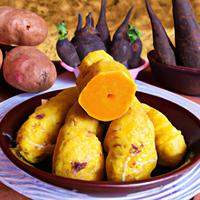
1 serving (100 grams) contains 120 calories, 1.1 grams of protein, 0.1 grams of fat, and 27.9 grams of carbohydrates.

Log this food in SnapCalorie

Nutrition Information
Calories |
285.7 | ||
|---|---|---|---|
% Daily Value* |
|||
| Total Fat | 0.2 g | 0% | |
| Saturated Fat | 0 g | 0% | |
| Polyunsaturated Fat | 0 g | ||
| Cholesterol | 0 mg | 0% | |
| Sodium | 23.8 mg | 1% | |
| Total Carbohydrates | 66.4 g | 24% | |
| Dietary Fiber | 9.8 g | 35% | |
| Sugars | 1.2 g | ||
| protein | 2.6 g | 5% | |
| Vitamin D | 0 mcg | 0% | |
| Calcium | 40.5 mg | 3% | |
| Iron | 1.2 mg | 6% | |
| Potassium | 1021.4 mg | 21% | |
* Percent Daily Values are based on a 2,000 calorie diet. Your daily values may be higher or lower depending on your calorie needs.
Food Attributes
Source of Calories
About Ubi
Ubi, also known as purple yam, is a vibrant root vegetable native to Southeast Asia, particularly the Philippines, where it is celebrated in traditional desserts and culinary dishes. This starchy tuber is rich in essential nutrients, including vitamin C, potassium, and antioxidants, which support immune health and help combat oxidative stress. Its deep purple color is due to anthocyanins, compounds known for their anti-inflammatory and heart-protective properties. Ubi is naturally sweet and often used in jams, cakes, ice creams, and even savory dishes. While it’s a nutritious food, preparation methods can affect its healthfulness; frying or combining it with sugar and high-fat ingredients can add excessive calories. When cooked simply, ubi is a fiber-rich, energy-boosting addition to a balanced diet. Its unique color and flavor make it a delightful choice for both traditional cuisines and innovative dishes worldwide.



